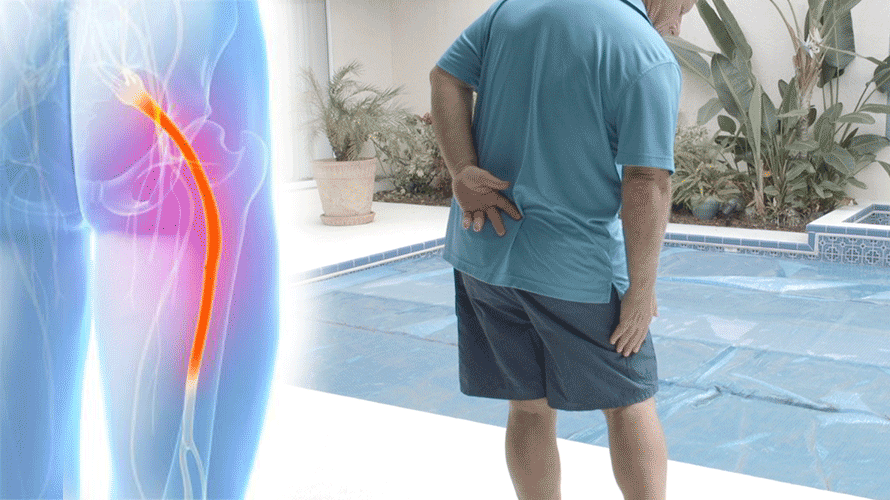This blog is excerpted from a Spine-Health article by Adaku Nwachuku, DO on January 23, 2020.
Leg pain and foot pain vary in type and severity and typically depend on a person’s lifestyle and associated medical problems. In addition to leg pathology, leg pain may be caused by a condition affecting the lower back, hip, or pelvic region. The type of pain may differ based on the underlying cause.
Spinal Causes of Leg Pain
Problems in the lower spine may affect the spinal nerve roots, causing pain to radiate into the leg and/or foot (radiculopathy). Common causes of leg and foot pain that originate in the spine include:
- Herniated discs: Bulging or leaking out of an intervertebral disc’s inner contents (nucleus pulposus).
- Spinal stenosis: Narrowing of the small bony openings (foramina) for spinal nerves.
- Degeneration: Arthritic or age-related changes in a disc, vertebral bone, or vertebral facet joint.
- Spondylolisthesis: Forward or backward slipping of a vertebra over the next lower vertebra.
Compression of the spinal cord in the neck and/or cauda equina in the lower back can also cause leg pain.
Blood Vessel Causes of Leg Pain
The arteries and/or veins in the legs may get inflamed or blocked, causing leg and foot pain. Common causes include:
- Peripheral artery disease: Decreased circulation caused due to blocked arteries.
- Deep vein thrombosis: Blood clot in the deep vein(s) of the leg causing decreased or altered blood flow.
- Superficial thrombophlebitis: Blood clots in the superficial veins of the leg causing varicose veins or spider veins to form underneath the skin surface.
Blood vessels may also get ruptured and cause bleeding within the tissue spaces of the leg, causing acute pain and swelling.
Pelvis and Hip Related Causes of Leg Pain
Pain from the joints and/or muscles of the pelvis and hip may be referred into the legs. Common causes include:
- Piriformis syndrome: Spasm of the piriformis muscle in the pelvis impinging the sciatic nerve.
- Sacroiliac joint dysfunction: Abnormal motion or malalignment of the sacroiliac joint.
- Hip osteoarthritis: Wear-and-tear arthritis of the hip joint.
- Trochanteric bursitis: Inflammation of a fluid-filled sac (bursa) on the side of the hip.
Pelvic bone fractures or other hip joint problems due to trauma, overuse, or degeneration may also cause leg pain.
Leg Pain due to Nerve Damage
Certain medical conditions may cause damage to the peripheral nerves in the leg. Common causes are:
- Metabolic conditions, such as type 2 diabetes mellitus or hypothyroidism.
- Infections, such as bacterial infection of the vertebral bone and disc, epidural abscess (accumulation of pus in the epidural space surrounding the spinal cord), herpes zoster, HIV, and/or Lyme disease.
Rarely, autoimmune conditions such as Guillain-Barré syndrome, where the body’s immune system attacks the peripheral nervous system may cause leg pain.
Nutritional Causes of Leg Pain
Deficiency of certain vitamins and minerals may cause damage to the peripheral nerves (peripheral neuropathy) resulting in leg pain and/or weakness. Typical nutrient deficiencies include:
- Vitamin B12
- Vitamin B6
- Copper
Excessive intake of alcohol and heavy metals, such as arsenic, thallium, or mercury may also cause peripheral nerve damage and pain in the legs.
Causes of Foot Pain and Numbness
Certain conditions may cause pain and/or numbness in the foot with or without leg pain. Foot pain commonly occurs in:
- Tarsal tunnel syndrome: Compression of the tibial nerve due to trauma, swelling, poorly fitting shoes, tendon problems, or enlarged arteries or veins.
- Peroneal neuropathy: Compression of the peroneal nerve due to trauma, tumors, or other systemic conditions.
- Sural nerve entrapment: Compression of the sural nerve due to tumors, scar tissue, or from wearing tight ski boots.
- L5 and/or S1 radiculopathy: Compression of the L5 or S1 nerve roots in the lower back.
Severe foot weakness can cause foot drop (inability to lift the foot off the ground).
Risk Factors for Leg and Foot Pain
A few risk factors associated with leg and foot pain include:
- Advanced age
- Genetics
- Poor posture
- Occupations, such as heavy labor, sports, or military service
While the listed causes and risk factors are not comprehensive, one or more of these conditions are typically associated with leg and foot pain. Several causes of leg pain can produce overlapping signs and symptoms. It is important to accurately diagnose the underlying cause of leg pain in order to effectively treat the condition as well as rule out serious problems, such as tumors, infections, or nerve damage.
Find Leg and Foot Pain Relief at the Bonati Spine Institute
It is important to seek medical attention immediately if serious leg and foot symptoms develop. If hip-related and blood vessel issues have been eliminated from your diagnosis, the Bonati Spine Institute has patented procedures to eliminate leg and foot pain, numbness, and other debilitating symptoms, due to spinal causes. In the 35 years we have been open, we have performed over 70,000 outpatient procedures WITHOUT the use of hardware or devices being permanently inserted into the spine. Guests have, and can, feel relief immediately after surgery! If you’d like for us to take a look at your case and verify if our Bonati Spine Procedures can help you, please call us at 855-267-0482 or complete our online contact form here and an advocate will reach out to you directly to discuss your case.
Read the full Spine-Health article here: https://www.spine-health.com/conditions/leg-pain/causes-leg-pain-and-foot-pain

